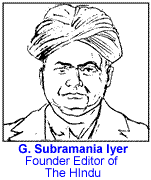|
Raja Ram Mohan Roy also started a Persian newspaper,
Mirat-ul-Akhbar in 1822.
After the suppression of the great revolt of 1857, the battle between the
Indians and the Europeans shifted to the pages of the newspapers. The Indian
press, by and large, had not lent its support to the revolt but afterwards when
the European press mounted an attack on Indians, calling them perfidious and
unworthy of trust, the Indian press stoutly defended their countrymen. When Dr.
George Buist, Editor of Bombay Times continued his attack on Indians, Mr.
Nowroji Furdoonji, one of the Indian shareholders insisted that the editor be
asked to moderate his tone. Buist refused to change and he was replaced by
Robert Knight.
Under the new editor, the Bombay Times became the leading pro-Indian paper of
the Anglo-Indian press.
In the post-revolt years, Harishchandra Mukherjee of the Hindu Patriot,
published from Calcutta emerged as an outstanding journalist. He was described
as "a terror to the bureaucracy as well as the white colonists and planters in
Bengal."
Another distinguished journalist was Man Mohan Ghosh who broke the news of the
indigo agitation through the columns of the Hindu Patriot, resulting in the
appointment of the 'Indigo Commission of Enquiry'.
In 1862, 1,200 railway workers went on strike at Howrah Railway station
demanding an 8-hour working day. Dwarkanath Vidya Bhushan, the editor of
Somprakash gave extensive coverage to the strike and wrote in support of the
strikers.
Paying rich tribute to the native press of those days Rev. Long wrote: "The
native newspapers are humble in appearance, yet like the ballads of a nation
they often act where the law fails and as straws on a current they show its
direction. In them questions of sati, caste, widow re-marriage, kulin polygamy
have been argued with great skill and acuteness on both sides. They have always
opposed a foreign language being the language of the courts. The atrocities of
indigo planters and the blunders of young magistrates have been laid bare and
letters to the editor open out a view of native society nowhere else to be
found...
Some of the papers have correspondents and at the time of the Kabul and Punjab
Wars accurate information was regularly given of the progress of events".
 Newspapers
launched in the post 1857 period were more vocal in criticizing the bureaucracy.
Amrita Bazar Patrika launched in 1868 by Sisir Kumar Ghose and Motilal Ghose,
Bengalee started by Girish Chandra Ghose in 1862, the Hindu launched in 1878 by
a group of young men led by Subramania Iyer and Kesari an Newspapers
launched in the post 1857 period were more vocal in criticizing the bureaucracy.
Amrita Bazar Patrika launched in 1868 by Sisir Kumar Ghose and Motilal Ghose,
Bengalee started by Girish Chandra Ghose in 1862, the Hindu launched in 1878 by
a group of young men led by Subramania Iyer and Kesari an d
Maratha started by Bal Gangadhar Tilak and his associates in 1881 were quite
outspoken in the criticism of the government. Writing on the increasing
animosity between the English and the Indians Amrita Bazar Patrika wrote in 1868
: "The English want to keep the Bengalis down, the Bengalis want to stand up.
The English find that the Bengalis can no longer be cowed down by merely
bullying or bribery. So they adopt sterner measures…" d
Maratha started by Bal Gangadhar Tilak and his associates in 1881 were quite
outspoken in the criticism of the government. Writing on the increasing
animosity between the English and the Indians Amrita Bazar Patrika wrote in 1868
: "The English want to keep the Bengalis down, the Bengalis want to stand up.
The English find that the Bengalis can no longer be cowed down by merely
bullying or bribery. So they adopt sterner measures…"
When Dwaraknath Mishra, Judge of the Supreme Court and an avid reader of the
Patrika told Sisir Kumar Ghose that he found the language used in the Patrika
somewhat coarse, Ghose replied that the Patrika had been started to infuse a
sense of patriotism in the people of the country. "They are now more dead than
alive," he contended. "Our language has, therefore, to be loud and penetrating."
W.S. Blunt paid high tribute to the Hindu in 1884 by declaring that their
editors "contrasted by no means unfavourably with men of their profession in
London." | 
